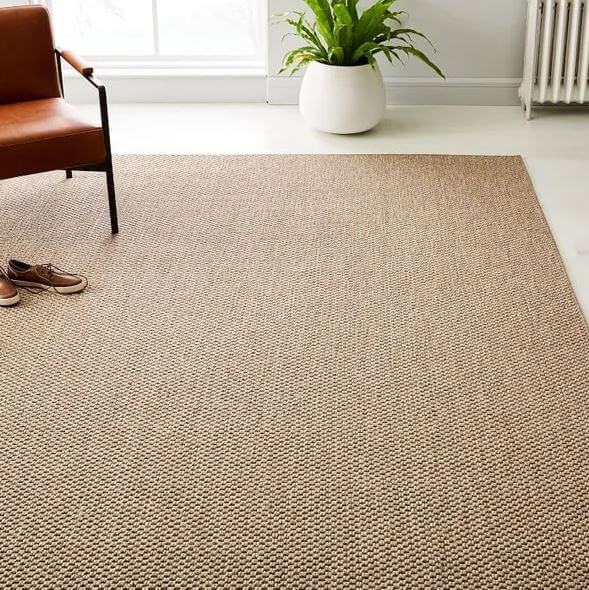In today’s home decor world, natural fiber carpets are more popular than ever. As eco-conscious living becomes a lifestyle choice rather than a trend, materials like sisal, jute, and seagrass are leading the way. Each fiber offers a unique combination of texture, color, durability, and sustainability. However, they are not all created equal — and choosing the right one depends heavily on your lifestyle, household needs, and personal aesthetic.
In this guide, we’ll dive deep into Sisal carpets vs jute vs seagrass to help you find the perfect natural fiber carpet for your home.
Understanding the Basics
Before we compare, let’s get familiar with each fiber:
- Sisal: Harvested from the agave plant, sisal fibers are strong, stiff, and durable. They are often woven into tightly textured carpets and rugs that add a sophisticated, natural look to any space.
- Jute: Known as the “golden fiber,” jute comes from the stalks of the jute plant. It’s softer than sisal and has a looser weave, giving it a more casual, earthy appeal.
- Seagrass: Grown in saltwater marshes, seagrass has a natural waxy coating, making it extremely resistant to stains and moisture. Its texture is smooth yet strong, often featuring a slight sheen.
Durability and Performance
Sisal leads the pack in terms of strength and durability. It’s an excellent choice for high-traffic areas like hallways, entryways, and staircases. Its firm fibers hold their shape and withstand heavy use. However, sisal is not very forgiving with spills, as it can stain easily if not protected or treated quickly.
Jute is softer and less durable compared to sisal. It is better suited for low-traffic areas such as bedrooms or formal living rooms where comfort is prioritized over toughness. Because jute is softer, it tends to wear down faster in busy parts of the home.
Seagrass offers an interesting middle ground. Thanks to its natural water resistance, it’s highly stain-resistant and performs well in spaces like dining rooms and home offices. Its durability is slightly less than sisal but greater than jute, especially when considering moisture exposure.
Texture and Feel
When it comes to underfoot comfort:
- Jute is the softest. If you walk barefoot at home or have children who like to play on the floor, jute offers a cozy, cushioned feel.
- Seagrass is smooth but firmer. Its waxy fibers create a slightly slick texture that feels polished but not rough.
- Sisal is the roughest. While it adds excellent texture visually, it’s not as pleasant under bare feet compared to jute or seagrass. Some people even choose to layer a soft rug over a sisal carpet for comfort and style.
Appearance and Color
Natural fiber carpets tend to come in earthy tones, but there are nuances:
- Sisal usually features creamy whites, beiges, and light browns. It holds dyes well, so it can be found in a wider variety of colors and patterns.
- Jute has a naturally golden, tan color, giving it a warm, rustic look. It generally isn’t dyed heavily because its fibers are more delicate.
- Seagrass tends to have a greenish tint when fresh, which fades into a soft khaki over time. Its sheen adds an elegant, slightly more refined appearance compared to the matte look of sisal and jute.
Maintenance and Care
Caring for natural fiber carpets is different from synthetic options:
- Sisal needs regular vacuuming to remove dirt before it settles. Immediate action is required for spills, as sisal can absorb liquids quickly.
- Jute is the most sensitive to moisture. Water can cause jute to weaken or stain permanently, so it’s crucial to keep it dry.
- Seagrass is the easiest to maintain among the three. Its waxy surface naturally repels dirt and liquids, making cleaning relatively hassle-free.
Tip: None of these natural fibers should be steam cleaned. Dry cleaning methods or simple spot cleaning are recommended.
Environmental Impact
All three fibers are sustainable choices. They are biodegradable, renewable, and generally produced using environmentally friendly methods. However, seagrass stands out slightly because it grows rapidly without the need for fertilizers or pesticides, making it one of the most eco-friendly flooring materials available.
So, Which One Should You Choose?
Here’s a quick lifestyle guide:
- Choose Sisal if you want a sophisticated, durable carpet for busy spaces and don’t mind a slightly coarser texture.
- Choose Jute if softness is your top priority and you need a stylish addition to low-traffic areas.
- Choose Seagrass if you need a resilient, moisture-resistant carpet that balances beauty and functionality effortlessly.
Ultimately, the best natural fiber carpet for you depends on your daily habits, the traffic in your home, and the vibe you’re aiming to create.
Final Thought:
Natural fiber carpets like Sisal Carpets Dubai, jute, and seagrass don’t just bring warmth and texture to a room — they connect your living space to nature, offering a timeless, eco-conscious style that synthetic materials simply can’t replicate.

